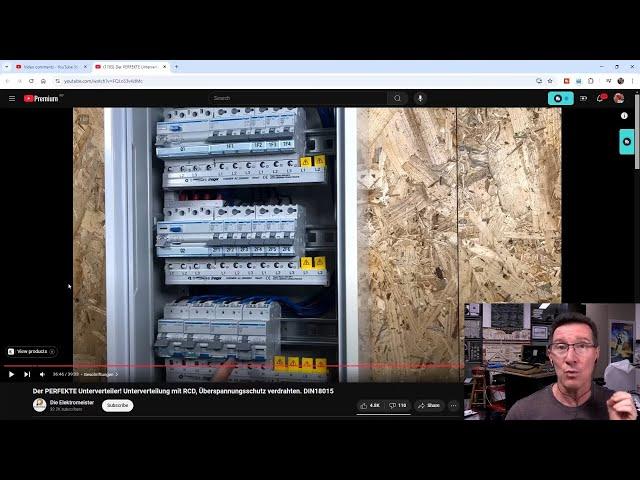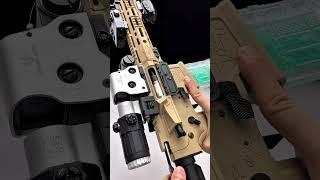
eevREACTS - European Electrical Switchboard Wiring
Комментарии:

UK seems to be set on RCBOs on every circuit now, split boxes falling out of favour. The Ring Final is falling out of favour for radials in new builds but Ring Mains are still very prevalent, in kitchens because of the cable loads. 2x2.5mm cables are easier to manage in UK sockets than 2x 4mm. Like any country new installations are very similar - however it's the older installations where significant differences between or even in countries is evident. I have seen some very dodgy installations in parts of Europe as well as 110% perfect ones.
Ответить
If you want to know how EU wiring is "really" done (and passenger plane fusebox) then watch Electroboom channels travel videos
Ответить
This is a typical german panel, how it's done varies a lot across Europe as every country has its own traditions, national standards on top of the CEE ones and some times different distribution systems (most common are TT and TN-C-S, with a bit of IT in Scandinavian countries).
Ответить
What is the reason for the aussie box to be outside? (don't you guys know water and electricity don't go wel together) 😁🤣
Ответить
I hope that bracelet is not a daily wear for that guy. Bracelets and switchboards do not go together. Never heard the one about stranded wire and "ferrules"(Boot lace crimps) They are required in some cases of meter wiring here in Aus but otherwise must be a European thing. If the customer isn't a penny pincher then you can offer all kinds of artistry but at the end of the day who cares? Only the Nietenzähler
Ответить
I specified a Hager electrical board using DIN rails for my Australian knock-down rebuild. It cost more and probably adds zero value but it does look very neat.
Ответить
Dave did you say that there was going to be a new model of the clamp meter coming out? My EEVblog clamp meter non contact voltage detector thinks there's ACV every where.
Ответить
In Australia it is mandatory to leave space in the switchboard for huntsman spiders.
Ответить
I'm building a house and recently bought like +1000 of these ferrules, called tubular terminals here in Brazil, for 1.5/2.5/4.0/6.0/10.0 mm² multi-stranded wires. They can slip or be torn if inserted directly on miniature circuit breakers, surge protectors and leak current protectors. They make installation a lot easier.
They were more expensive than cheap Chinese terminals because they are made from tin-platted electrolytic copper and fire-retardant Nylon-66, which I've tested and confirmed to be.

try auto-translated subtitles. they very often work surprisingly well!
Ответить
But is there a difference between the components used? RCDs, GFCIs, etc. (I'm not an electrician so I'm not sure if those are even used in fuse boxes or are part of the outlets (UK thing I think?))
Ответить
This looks like a modern panel in Aus. Victoria is a bit different to NSW though
Ответить
It's called bootlace ferrules not just ferrules.
Ответить
I don't get the excitement of people here (I am German btw). This is not really different than what Dave has. It is just a 3 phase job (which is usual here), so it looks bigger and "more crazy". But in the end, it covers the same functionality. Of course, the housing is new and has shiny metal DIN rails and the wiring is new, but hey, why would you scrap those from Dave's existing installation? Just a wast of resources.
Ответить
Clipsal makes the same style all metal din rail switchboard. Have them in my house.
Ответить
You should see what a switchboard is in an old building in Paris.
Best way to describe how these buildings are wired is : fire hazard. Wooden enclosure, coton wrapped wires, porcelain fuses replaced by random bit of wires, and of course next to it there is a natural gas pipe.
When these places finally gets renovated, the new electrical installation is put on top of the old, that stays disused, with wires for switches and outlets cut and plastered on. A fuel for nightmare.
Correctly done new construction or meticulous renovation work looks like the video of this german guy. But it's pretty rare. But most of the time, it's okay-ish code compliant and no more. Not many cable management pRn lovers here in France.

That is from Germany. I wish all of the switchboxes here were done like this
Most of them I came across are either:
a thousand years old and falling apart (Harrison Ford screaming: THIS BELONGS IN A MUSEUM!!)
500 Years old and got "fixed" and added stuff to it a thousand times by "I know a friend who is an electrician"
or done by some dude with minimum required knowledge about how to do things. Like screws not tightened, wrong size breakers and so on
Almost all of them had no proper or wrong labeling and documentation

This Metal box has a plastic liner on the inside. This way it still counts as double insulated and won't be grounded.
This is the normal way to do it here in Germany (where also the video is from).

The Box shown here is only IP44 rated. Here in Germany this would only be used inside.
For a retrofit like yous, we would have used something with at least IP54, better IP65 rating, since it is outdoors. This would keep insects and condensation out.
The box then would be mounted solidly to the wall. Mounting it like in your upgrade video won't be OK, since solid wires are not supposed to be repeadedly bent after insallation.
Also having the cladding of the cables removed outside the fusebox won't be OK here. (The existing Metal box probably won't count, since the breakers are in another box)
The inside of the box won't look that different. I would leave a lot more room for future expansion, but that is a matter of preference.

Aren't phases upside down in Australia?
Ответить
You should really have a look at the Phoenix terminals. They are used to separate the internal cabling from the box to the outside cables. You could complete the box somewhere else completely and then bring it on side. And then just connect all the cables from the walls to the Phoenix terminals in the top. This makes it also very convenient when you want to change anything internally, because you don't have to rely on whatever length of cable you have from the house installation.
As far as I know the Phoenix are not normally used in German house boxes. They are more likely used in office buildings or industry. But they are great. Outside of Germany they are also expensive. I imported a big box of them from Germany to do my electrical home installation in Bangkok.

The red thing is a three phase surge protector.
Ответить
Now let's start a discussion about wire nuts. 😂
Ответить
You should look at a US/Canada load centre. Wildly different.
Ответить
I use ferrols for stranded wire. Makes it a bit easier to put the wire in fuses and makes it look nice. There is nothing wrong using them cause thay are kinda thin and will bend and crush when tightened to spec. Mostly thay are used in automation because of stranded wire. In residential mostly we use solid cable.
Ответить
Now do USA panel, with the integrated bus bars it feels like a much simpler setup
Ответить
I thought it was great you could open the door and get to the back of the gear in the Aussie one. See what they do in Turkey! 8@O
Ответить
This wiring job is to Dave's what Dave's wiring is to my cable management. It's one thing to design a layout from scratch from the start, but to work from and existing hodgepodge really takes talent. :)
Ответить
As a server engineer , i can only dream of IT guys discussing cabling like this. Its almost a badge of honour in IT to have your comms cables looking like spaghettti, but still working. Bonus points for no labelling, documentation, and a ton of "clever" wiring hacks that always turn out to be the source of the problems. Worst part is electrical faults always get blamed on the electrical installer, and the electrical installation is usually the only thing on site wired to spec and corrrectly. Its never, ever the customer fitted $200 home PC UPS wired in series to 20 servers, or the comms room pulling triple the load it was specced for.
Ответить
different . . . messy!
Ответить
Now do a US one so everyone can freak out in the comments 😂
Ответить
UK code is mostly the same and maybe in a language more consumable.
Ответить
meh probably gotta redo that with cc on we do stuff around here very differently and no this is not a new housr from what it looks like. this is more of a show and tell thing we dont put our junction boxes on OSB boards usually
neither do our boards swing open like yours (removing the need to have your length of wire allowing for the ratsnest you had) and also it seems like he ist doing it to the end b/c we usually put covers on the unused spaces and specifically only remove them temporarily when doing addons after the fact or maybe for troubleshooting

I don't understand why anyone would just defend bad practice.
And unfortunately there are plenty of bad practices in Europe (or anywhere in the world for that matter) as well, which are defended with the same bad fallacy "this is how we do it".
Rats nests of wires are just poor electrical design.

Be more inclined to hear the commentary about North American electrical panels (bus bars instead of independently wired breakers).
Ответить
Dude, you're in Australia, not Austria. There's probably not a locally cached copy of German electrician content... So it's trying to download from the EU.
Ответить
The red “block” is a SPD (surge protection device).
Ответить
Making the wiring looks nice, but I'm not willing to pay the extra labor for just that showmanship. It functions no better
Ответить
We have the 35mm Rail System and many things to make it easy and clean. Not only Haiger but Siemens, ABB, Schneider, Eaton (Ex Klöckner-Möller) and some others. This is all connected with the VDE Rules/Standards ( Verband der Elektrotechnik Elektronik Informationstechnik e.V. Oganisation of the Elektrotechniques, Elektronik and Informationtechnology)
Ответить
Masturbater
Ответить
I love the plastic in home dutch consumer distribution.
It's very versatile 😄

You mention that you could specify how the switchboard should be built in AU. That's a difference, and not possible here, at least not in my country (Norway). Here we can only specify where we want the outlets and switches to go, but the intake and switchboard layout is up to the professionals to decide. We can certainly ask for a bigger cabinet, to allow for future expansions, but we cannot instruct what kind of enclosure, breakers or circuits to be installed.
EDIT: Ferrules are not that common, maybe in Germany ;)

If I'm recognizing the language, the narrator is speaking German, which means this is probably in Germany, where 3-phase power in residential homes is the norm. That's going to be slightly different than the layout in, for example, North America where split-phase (two hots and a center-tapped neutral referenced to ground) is the norm in residential. (Larger commercial and industrial buildings often have 3-phase, to better drive the electric motors in the HVAC and industrial machines. Restaurants may use what's called 'red-leg,' where one phase of 3-phase is used, giving an RMS of 207V to ground. You don't want to cheap out and connect something like a 207V commercial toaster to 240V. It will burn out elements, often quite dramatically, with lots of arcing, bright light, and bits of molten metal being thrown out of the device. I saw that several times.)
Ответить
TLDR; No surprises here, apart from ferrules and stranded wire. This type of ABB enclosure is exactly what I'd expect to find in an indoor box in Australia, with the exact same DIN rail arrangement. Would be expected inside a new build apartment or large mansion that has a dedicated indoor switchboard room.
It would be just as messy as mine if you added 9 current clamps behind it.


























